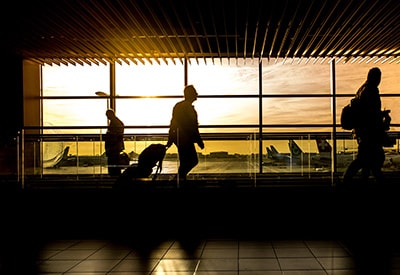How to Deal with Short Layovers

Flight Search in Progress
Scanning the skies for available flights...
- Airlines will always try to sit children with their parents (subject to check-in)
- Some airlines will allow travel for unaccompanied minors. Please email us to check.
- The fare is based on the child's age on the date of travel.
- More detailed information can be found here Traveling with children
- Most airlines will let infants travel with their parent(s) for free. However some airlines will charge up to 10% of the adult ticket price. Click on 'Price Breakdown' to find out more.
- If you are pregnant, but due before the flight departure date, please contact us once your baby is born and has a name. We can then add him/her to your ticket.
- Infants will not be given a seat. The airlines expect parents to travel with them on their lap.
- Airlines regard infants as being under 24 months old.
- The fare is based on the child's age on the date of travel.
- More detailed information can be found here Traveling with children
How to Deal With
A Short Layover
Booking a flight with a short layover can often be the cheapest option. But how short is too short a layover? And what about short layovers on international flights? Find out everything you need to know in our helpful guide to short layovers...
Short Layover FAQs

What is a short layover?
Simply put, a layover flight is a flight with a stop in the middle. Sometimes, this will mean staying on the aircraft while it lands to drop off and pick up passengers. Other times, it will mean you have to get off the plane and board a new one at the airport. When you only have a very limited time to make your connecting flight, this is called a short layover (or a tight connection). A layover is different from a stopover, which is normally over 24 hours and may allow you enough time to explore the place you're stopping. You can learn more about long stopovers with our blog on planning the perfect stopover.
What is considered a short layover?
Whether a layover is considered short or long will vary depending on whether it is an international or domestic layover flight. The recommended layover time for international flights is generally longer, as you will have to go through customs and immigration before boarding your next flight. In most cases, a 30-minute layover for domestic flights and an hour for international flights is considered a minimum, or short, layover.
Is my layover too short?
It's common to worry that your layover is too short. And, unfortunately, there isn't an easy way of knowing if your layover will be long enough to make your connection. While airlines won't sell a flight that doesn't provide you with adequate time to make your connection, in reality, you might need a bit longer to make your connection. Try to take into account the time you will need to go through customs and immigration for international layovers. You may also need to consider the time it takes to change terminals if your flights are with different airlines and also the size of the airport you are traveling to. Allowing yourself at least a 60-minute layover for domestic flights and a two-hour layover time for international flights can often be a much more comfortable and stress-free journey than booking a flight with a very tight connection. If you require special assistance at the airport, you may need to arrange a much longer layover.
What is the recommended layover time for international flights?
International flights require longer connections as you will often have to go through immigration and customs upon arrival. For international layover flights booked on one airline, two hours is often recommended to make your connection. For international flights on different airlines, the connection time will need to be even greater as you may have to change terminals between the two flights. You may also have to claim and re-check your baggage. Other factors to take into account include the time of year (is it peak tourist season?) and the size of the airport you're flying into. If your connecting flight leaves from a notoriously busy airport, it may be necessary to arrange a layover that's at least three hours long.
What is the recommended layover time for domestic flights?
The recommended layover time for domestic flights is normally one hour. However, as previously stated, you may require longer if your flights are booked with two different airlines, if you are traveling to a very busy airport or if you require special assistance.
What happens to my checked baggage on a layover flight?
Normally, when layover flights are booked with the same airline, your baggage will be automatically transferred through to your final destination. However, if the two flights are with different airlines, you may have to claim and re-check your baggage during your layover. On interline flights (where two airlines agree to handle passengers with multiple legs in their journey), your baggage will be transferred automatically. For international layovers in the US and Canada, you will have to collect and recheck your luggage independent of whether the flights are booked on the same airline. To be sure about what will happen to your baggage during your layover, always ask the airline staff what will happen to your baggage when checking in for your first flight.
Do I have to go through immigration and customs for a layover?
For international layover flights, you will normally have to go through customs and immigration at the connecting airport. For flights with a layover in Canada or the USA, you will need to go through immigration and fill out the necessary customs paperwork even if you are not staying in the country. If your international layover is within the Schengen Zone, you will not have to go through customs and immigration for your layover. For example, if you are flying from France to Spain and then onto Mexico, you will only have to go through customs and immigration upon arrival in Mexico.
Do I have to go through security for a layover flight?
For domestic to domestic layovers, you normally won't have to go through security again during your layover. However, for all international layovers, you will normally have to go through security again, but this will depend on individual airport policy.
What happens if my first flight is delayed?
If your first flight is delayed because of technical or maintenance issues, the airline will help you book onto the next available flight. However, this may only be the case if both flights were booked on the same ticket. Or, if both flights are with the same airline or partner airlines.
What happens if I miss my flight connection due to a short layover?
If the missed connection is due to the fault of the airline (i.e. the first plane is delayed due to a technical fault) and you are booked onto a "through ticket" (one ticket for the entire journey) then it is the airline's responsibility to help you book another flight. If you miss the connection through fault of your own, then the airline is under no obligation to help you re-book. If the two flights are on separate tickets, the airlines are not likely to take responsibility for a missed connection and you may have to purchase a new ticket yourself.
How to prepare for a very
short layover
1. Change your flight
If you think you've been sold a flight with an impossibly short layover, consider contacting the airline or Alternative Airlines to change your flight for better peace of mind. If this isn't possible, follow the tips below to help you prepare for your tight connection.
2. Sit at the front of the plane
We've all had to wait at the back while the people at the front leave the plane before us. Reserving a seat at the front, or in particular, the front left of the plane can mean a much quicker exit for passengers with a very short layover.
3. Only take carry-on baggage
Having to claim your checked baggage and re-check it can be time-consuming. Avoid the hassle altogether by only taking carry-on baggage on your short layover flight.
4. Eat on the plane
Reduce the need for stopping at the airport during your short layover by making sure you've had something to eat and been to the bathroom on the plane.
5. Ask the flight attendants and airport staff for help
Airline and airport staff are there to help you. While on your flight, ask the staff if they know which gate your next flight is taking off from. When you land, the airport staff can also help you make your way to your connecting flight.
6. Learn about the airport layout
Downloading a map of the airport ahead of time, or finding out the terminal where your next flight leaves, can also help you avoid getting lost at an unknown airport when your connection time is tight.
